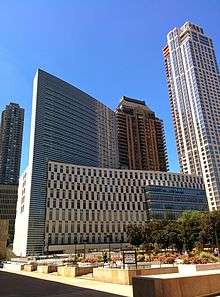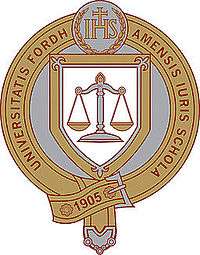Fordham University School of Law
|
Fordham University School of Law seal features university and school name in Latin, the scales of justice, and the 1905 date of the school's founding. | |
| Latin: Universitatis Fordhamensis Iuris Schola | |
Motto in English | In the Service of Others |
|---|---|
| Type | Private[1] |
| Established | 1905 |
| Affiliation | Catholic, Jesuit |
| President | Rev. Joseph M. McShane S.J. |
| Dean | Matthew Diller[2][3][4] |
| Postgraduates | 1,500 |
| Location | New York City, New York, United States |
| Campus |
Lincoln Center (Manhattan): Urban, 8 acres (32,000 m2) |
| Colors | Maroon and White |
| Nickname | The Rams |
| Mascot | Ram |
| Website | http://law.fordham.edu |






Fordham University School of Law (commonly known as Fordham Law or Fordham Law School) is a part of Fordham University in the United States. The School is located in the Borough of Manhattan in New York City, and is one of eight ABA-approved law schools in that city. In 2013, 91% of the law school's first-time test takers passed the bar exam, placing the law school fifth-best among New York's 15 law schools.[5]
According to Fordham University School of Law's 2014 ABA-required disclosures, 67.8% of the Class of 2014 obtained full-time, long-term, JD-required employment nine months after graduation.[6]
Overview
According to the information reported to the American Bar Association, 1,151 J.D. students attended Fordham Law in 2015-2016.[7] There are 956 full-time students and 195 part-time students. Fordham Law also offers Master of Laws (LL.M.) degrees in the following specializations: Banking, Corporate, & Finance Law; Corporate Compliance; Fashion Law; Intellectual Property & Information Technology Law; International Business & Trade Law; International Dispute Resolution; International Law & Justice; and U.S. Law.[8] LL.M. students can take a second concentration after finishing the first one by enrolling in a third semester.[9] Fordham University offers a "3-3 Program" that allows students to earn a Bachelor of Arts or Bachelor of Science and a Juris Doctor in six years of study: three at Fordham College and three at Fordham Law.[10] Fordham Law offers three joint degrees in conjunction with Fordham University's other graduate schools: J.D./M.A. in International Political Economy and Development; J.D./M.B.A.; and J.D./M.S.W..[11]
The School also offers a Master of Studies in Law (M.S.L.) degree with specializations in Corporate Compliance and Fashion Law,[12] as well as a Doctor of Juridical Science (S.J.D.) degree,[13] which is full-time, research-based[14] and culminates in a dissertation of at least 50,000 words.[15]
Founded in 1905, Fordham Law commemorated its Centennial during the 2005-2006 academic year, and capped the year-long celebration with an alumni gala on Ellis Island on September 28, the school's official birthday. The school used the occasion of its Centennial to launch a new fundraising drive in 2005, and in just one year had raised more than $10 million thanks in large part to the more than 100 "Centennial Founders" who each contributed $100,000 or more.
The current dean of Fordham Law School is Matthew Diller.[16][17]
Statistics
In the 2016 edition of U.S. News & World Report's "Best Graduate Schools," Fordham Law was ranked 34th.[18] It has the highest ranked part-time law program in New York state (ranked 3rd in the nation in the 2016 edition.)[19] Additionally, five specialty programs were nationally ranked: Dispute Resolution, 13th; Trial Advocacy, 13th; International Law, 15th; Intellectual Property, 16th; and Clinical Training, 22nd.[20]
According to the American Universities Admission Program's LL.M Rankings, the Fordham Law LL.M program was ranked 6th nationally in 2012.[21]
According to The National Law Journal, Fordham Law ranks 20th in percentage of class of 2014 graduates hired by "NLJ 250" firms (firms with 100 or more lawyers) [22] and 23rd in the number of alumni promoted to partner.[23]
In 2015, 85.2% of the law school's first-time test takers passed the bar exam, placing the law school fourth-best among New York's 15 law schools.[24]
In a national study of the scholarly impact of law school faculty, Fordham Law’s tenured professors were tied for 35th.[25][26] The study looks at citations of faculty articles from 2010 through 2014.
Campus
Originally located in New York's downtown Financial District, Fordham Law is currently located on the West Side of Manhattan, as part of Fordham University's Lincoln Center campus. As part of the university's Lincoln Center Master Plan, unveiled in 2005,[27] a new law school building was built. The building took three years to complete, following the groundbreaking on May 2, 2011.[28] The new law school building is part of the university's Phase 1 redevelopment of its Lincoln Center Campus.[29]
The 22-story building was designed by Pei Cobb Freed & Partners to serve a dual-purpose for Fordham University: a nine-story pedestal (and lower level floor) houses the law school, and a 12-story tower serves as an undergraduate residence hall.[30]
The law school portion of the building was dedicated on September 18, 2014. Former New York City mayor Michael R. Bloomberg delivered the keynote address and U.S. Supreme Court Associate Justice Sonia Sotomayor also gave a speech before presiding over the ribbon-cutting ceremony.[31]
Academics
Legal writing program
Fordham offers an extensive legal writing program, with many course offerings beyond the first year. All legal writing courses are taught by adjunct professors.
Clinical education
The Clinical education program at Fordham Law is ranked 22nd nationally by U.S. News & World Report in its 2016 edition of America's Best Graduate Schools.[32] At Fordham, clinical education is available but not required. Students are selected for clinics via a competitive application process. Fordham students have an opportunity to enroll in clinics following their first year, and after taking the Fundamental Lawyering Skills course. Currently, 16 clinics are offered:[33]
- Appellate Litigation
- Community Economic Development
- Consumer Litigation
- Corporate Social Responsibility
- Criminal Defense
- Family Advocacy
- Federal Litigation
- Immigrant Rights
- International Human Rights
- International Law & Development in Africa
- Legislative and Policy Advocacy
- Mediation
- Queens DA Prosecution
- Samuelson-Glushko Intellectual Property and Information Law
- Securities Litigation & Arbitration
- Tax
Fordham's clinics represent clients as "Lincoln Square Legal Services," a small law firm housed within the school.
Crowley Program in International Human Rights
The Crowley Program in International Human Rights, named after the late Professor Joseph R. Crowley, was founded in 1997. It is a program of study in international human rights law undertaken in the 2L year, culminating in a two-week overseas fact-finding mission in the summer. Students in the program are known as Crowley Scholars.
Leitner Center
The Leitner Center for International Law and Justice works with students and with social justice organizations both locally and internationally to advocate for human rights.[34]
Public Interest Resource Center
Fordham's Public Interest Resource Center (PIRC) serves as the clearinghouse for student community service and pro bono work, and hosts 19 student-run organizations, including Habitat for Humanity, Unemployment Action Center, Just Democracy, and others. PIRC earned Fordham Law the American Bar Association's 2008 Pro Bono Publico Award, making Fordham Law only the second university winner in the award's history.[35]
Stein Scholars
The PIRC also runs the competitive Stein Scholars Program in Public Interest Law and Ethics, in which selected students train for a career in the public sphere and receive funding for doing unpaid public interest work.
Student publications
Students at Fordham Law publish six nationally recognized law journals. According to a recent study by Washington & Lee University, among journals published 2007-2014, they are ranked among the most cited in judicial opinions as follows:[36]
- Fordham Law Review
- 6th-most cited among all law journals
- Fordham Intellectual Property, Media & Entertainment Law Journal
- 6th-most cited of all IP journals
- Fordham Urban Law Journal
- 5th-most cited student-edited public policy journal
- Fordham Journal of Corporate & Financial Law
- 1st-most cited student-edited banking and finance journal
In addition, the study found that four of Fordham Law School's specialty law reviews are among the top ten most cited journals by law reviews in their respective specialty fields.[37]
- Fordham Environmental Law Review
- 10th-most cited of all environmental law journals
- Fordham Urban Law Journal
- 2nd-most cited of all public policy journals
- Fordham Journal of Corporate & Financial Law
- 1st-most cited among all banking and finance journals
- Fordham Intellectual Property, Media & Entertainment Law Journal
- 3rd-most cited of all IP journals
- Fordham International Law Journal
- 4th-most cited among student-edited international journals
Notable alumni
Fordham Law in popular culture
- The main character in Christopher Buckley's novel Supreme Courtship is a Fordham Law alumna. The Fordham Law dean and two faculty members volunteered as editorial consultants and reviewed early drafts of the book; they were Dean William Michael Treanor, and Thane Rosenbaum and Benjamin Zipursky.
- George Clooney's title character in the film Michael Clayton (2007) is a graduate of Fordham Law.
- The father in the movie Little Manhattan wears a Fordham Law T-shirt.
- In the Robert De Niro film, The Good Shepherd, John Turturro plays a CIA operative who is a graduate of Fordham Law.
- The film Rounders was written by two Fordham Law alumni and the fictional law school in the film was intended to have the look and feel of Fordham Law. Several Fordham-specific references are also made in the film (Mulligan Moot Competition).
- Frank Rossitano, a character on the NBC show 30 Rock, attended Fordham Law for a semester, but had to drop out when his mother became ill.
- Jamie Foxx's character in Law Abiding Citizen is a graduate of the Fordham Law School Evening Division.
- Michael J. Fox's character in the TV sitcom Spin City is a Fordham Law graduate. Many references are made through the show.
- Peter Scanavino's character Detective Dominick Carisi in Law and Order: Special Victims Unit attends Fordham Law School's part-time program.
- Michelle Hurd's character Samantha Reyes in Daredevil, is seen wearing a Fordham Law sweatshirt.
Employment
According to Fordham Law's official 2014 ABA-required disclosures, 80% of the Class of 2014 were employed full-time 10 months after graduation; 67.8% were in full-time, long-term, JD-required positions; 11.1% held positions the ABA classifies as "J.D. Advantage" (defined by NALP as "legal training is deemed to be an advantage or even necessary in the workplace"[38]); and 20.7% were employed in public sector positions in government, nonprofit organizations, and judicial clerkships.[39] Fordham Law's Law School Transparency under-employment score is 20.3%, indicating the percentage of the Class of 2014 unemployed, pursuing an additional degree, or working in a non-professional, short-term, or part-time job nine months after graduation.[40]
The law school was ranked # 21 of all law schools nation-wide by the National Law Journal in terms of sending the highest percentage of 2015 graduates to the largest 100 law firms in the US (19.5%).[42]
Costs
The 2015-2016 tuition at Fordham Law is $53,440 for full-time J.D. students and $40,080 for part-time J.D. students; the estimated fees, room and board, and other expenses total $27,996 for full-time and $27,906 for part-time students (not including a $2,529 student health insurance charge, which the school will waive for students who have alternative health insurance coverage).[43] The Law School Transparency estimated debt-financed cost of attendance for three years is $296,077.[44]
See also
References
- ↑ NAICU - Member Center
- ↑
- ↑
- ↑
- ↑
- ↑ "Class of 2014 at 10 months".
- ↑
- ↑
- ↑ Dual-Concentration
- ↑
- ↑
- ↑
- ↑
- ↑
- ↑
- ↑
- ↑
- ↑
- ↑ , Best Part Time Law Programs US News & World Report
- ↑ Fordham Law School News Release
- ↑
- ↑ http://www.nationallawjournal.com/id=1202718517845?slreturn=20150504235639
- ↑ http://www.nationallawjournal.com/id=1202718532243
- ↑
- ↑ http://leiterlawschool.typepad.com/leiter/2015/09/top-40-law-faculties-in-scholarly-impact-2015.html
- ↑ http://papers.ssrn.com/sol3/papers.cfm?abstract_id=2642056
- ↑ Fordham Unveils Lincoln Center Master Plan, press release, Aug. 26, 2005; Master Plan Unveiled, Inside Fordham Online, Mar. 2005
- ↑
- ↑ Fordham University Campus Development
- ↑
- ↑
- ↑ http://law.fordham.edu/newsroom/32663.htm
- ↑
- ↑ http://www.leitnercenter.org/about/
- ↑ ABA Pro Bono Publico Award - Current Recipients
- ↑ http://law.fordham.edu/about-fordham/5244.htm
- ↑ http://law.fordham.edu/about-fordham/5246.htm
- ↑
- ↑ "Class of 2014 at 10 months".
- ↑ "Fordham University Profile".
- ↑ "Class of 2014 at 10 months".
- ↑
- ↑ "Tuition & Cost of Attendance".
- ↑ "Fordham University Profile".
External links
| Wikimedia Commons has media related to Fordham University School of Law. |
Coordinates: 40°46′16″N 73°59′04″W / 40.77100°N 73.98444°W

